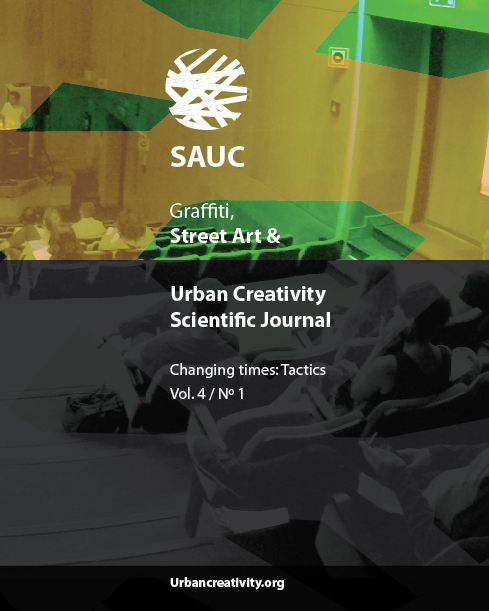Aesthetics of Change Multiculturalism and the street art of Footscray
DOI:
https://doi.org/10.25765/sauc.v4i1.121Palabras clave:
Multiculturalism, Gentri cation, Community, Culture, Street ArtResumen
Street art is considered by many as a cultural practice, which like all cultures, has its diversity within it. Through the analysis of three case studies, this article demonstrates the value in using multiculturalism as a framework for developing street art. This study is situated in the Melbourne suburb of Footscray in Australia, from 2014 – 2018 which has been undergoing urban development and gentri cation. Each case study features artists that have created a street art piece in the suburb during the research period. There are varied opinions about what constitutes street art and how to de ne a street artist. In order to contain our research, the article focuses on artists who create legal murals. Through an exploration of their work, techniques and intent behind their art, the article presents an understanding of the diversity that exists within the street art community. Culture and multiculturalism have broad interpretations and this research suggests understanding multiple perspectives from a lived experience to political forms of management and integration. Theoretical literature, are reviewed to explore how they are at work in contemporary discourses of government, arts and community. The setting for this research, Footscray, is known as a culturally diverse inner-city suburb, that has been reportedly going through the process of gentri cation. We examine gentri cation’s impact on social diversity and also explore the role of street artists as both gentri es and activists against gentri cation. This article intends to prove that the application of multicultural theory to street art projects can create community resilience during times of urban transition. Through this research, we investigate street art as a manifestation of the cultural diversity of the community. As such, it demonstrates how an understanding of multiculturalism from di erent perspectives, can provide a framework for the development of future street art projects by artists, communities and organisations.
Descargas
Estadísticas globales ℹ️
|
175
Visualizaciones
|
0
Descargas
|
|
175
Total
|
|
Descargas
Publicado
Cómo citar
Número
Sección
Licencia
Los autores/as que publiquen en esta revista aceptan las siguientes condiciones:
- Los autores/as conservan los derechos de autor.
- Los autores/as ceden a la revista el derecho de la primera publicación. La revista también posee los derechos de edición.
- Todos los contenidos publicados se regulan mediante una Licencia Atribución/Reconocimiento-SinDerivados 4.0 Internacional. Acceda a la versión informativa y texto legal de la licencia. En virtud de ello, se permite a terceros utilizar lo publicado siempre que mencionen la autoría del trabajo y a la primera publicación en esta revista. Si transforma el material, no podrá distribuir el trabajo modificado.
- Los autores/as pueden realizar otros acuerdos contractuales independientes y adicionales para la distribución no exclusiva de la versión del artículo publicado en esta revista (p. ej., incluirlo en un repositorio institucional o publicarlo en un libro) siempre que indiquen claramente que el trabajo se publicó por primera vez en esta revista.
- Se permite y recomienda a los autores/as a publicar su trabajo en Internet (por ejemplo en páginas institucionales o personales), una vez publicado en la revista y citando a la misma ya que puede conducir a intercambios productivos y a una mayor y más rápida difusión del trabajo publicado (vea The Effect of Open Access).













